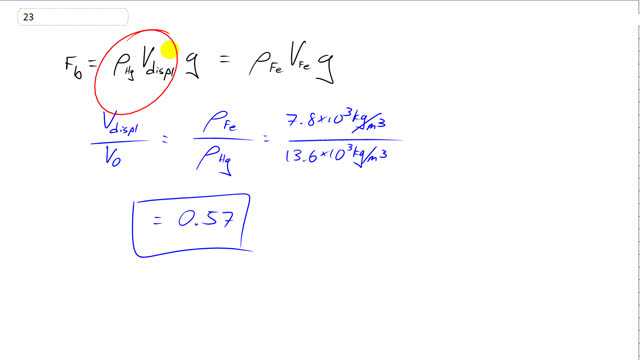
What fraction of a piece of iron will be submerged when it floats in mercury?

In order to watch this solution you need to have a subscription.
This is Giancoli Answers with Mr. Dychko. The buoyant force on the piece of iron that's floating in the mercury is gonna equal the density of the mercury times the amount of mercury displaced times g. In other words, the buoyant force equals the weight of the amount of mercury that's been displaced by having the iron there floating on top of it and pushing some of the mercury out of the way as some of the iron sinks into the mercury. So buoyant force equals weight of the fluid displaced—that's Archimedes principle— and that's gonna equal the weight of the iron because the buoyant force upwards on the piece of iron has to equal the weight downwards. Okay. So this is the density of iron times the volume of the iron which gives us the mass of iron, you know, we have kilograms per cubic meter times cubic meter gives us kilograms then times by newtons per kilogram, gravitational field strength, g, and so the buoyant force equals the weight in other words. and then we can solve this for V displaced divided by V of the object and that's gonna be density of iron divided by density of mercury. So I'm dividing both sides by density of mercury and volume of the object. So we just leave this V displaced divided by V on the left and the density of mercury cancels there and here I put V O but really that should be V Fe— volume of the piece of iron—volume of the object is what the "O" stands for and you have an "O" in your textbook so that's where that came from. And the volume displaced divided by the volume of the object is the fraction submerged because the volume of iron within the mercury is the volume of mercury displaced. I mean it's gonna displace as much mercury as there is iron within the mercury. (Does that make sense?) So if this is surface of your mercury and you have some chunk of iron and this much of it's inside the mercury then this is the volume of mercury displaced. So this gives us the fraction submerged: the amount of iron within the mercury divided by the total volume of the mercury piece. So that's 7.8 times 10 to the 3 kilograms per cubic meter—density of iron— divided by 13.6 times 10 to the 3 kilogram's per cubic meter—density of mercury— which is 0.57. So I guess this picture should look more like this where you have iron and this is 57 percent of the total block volume.